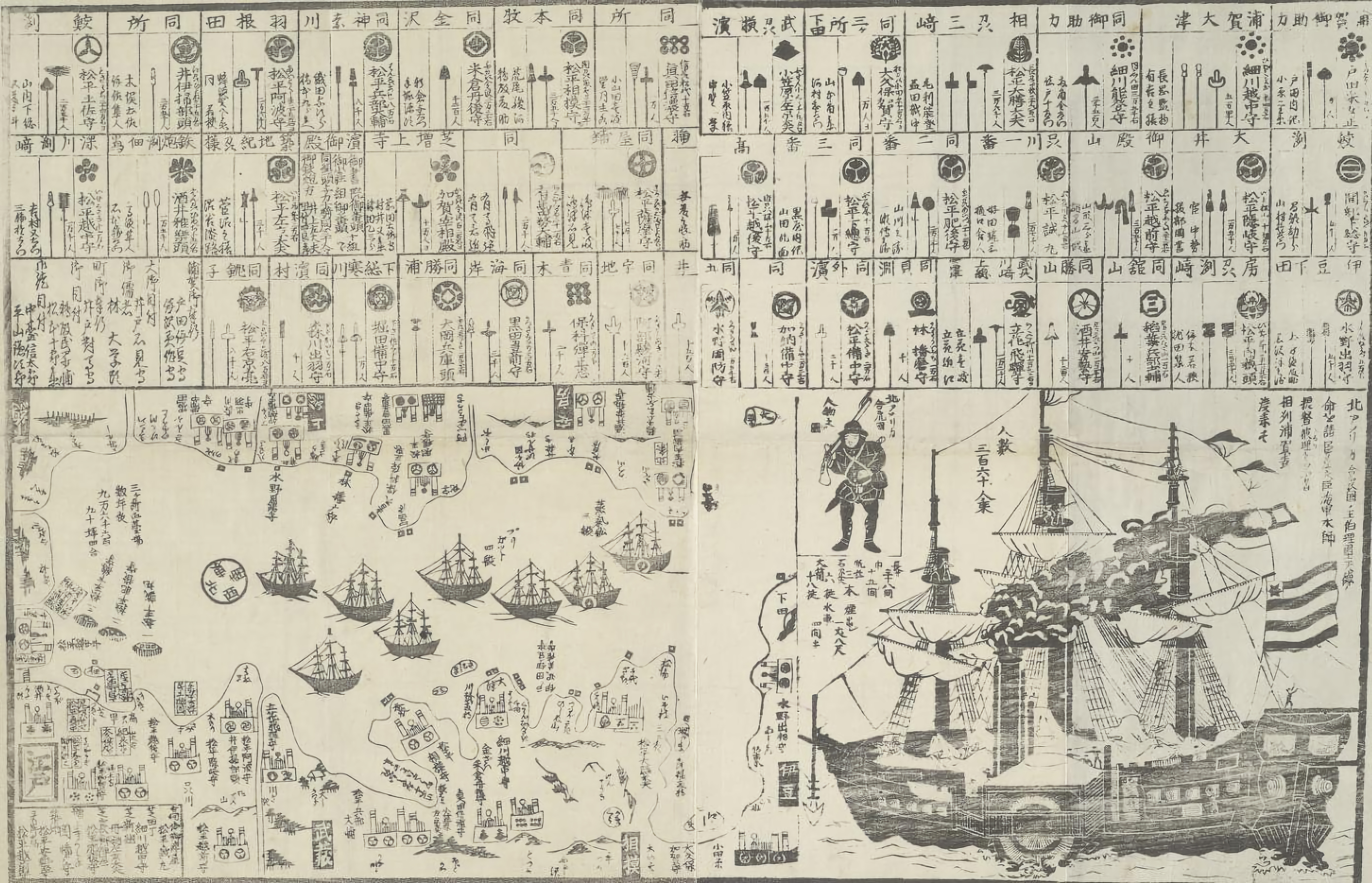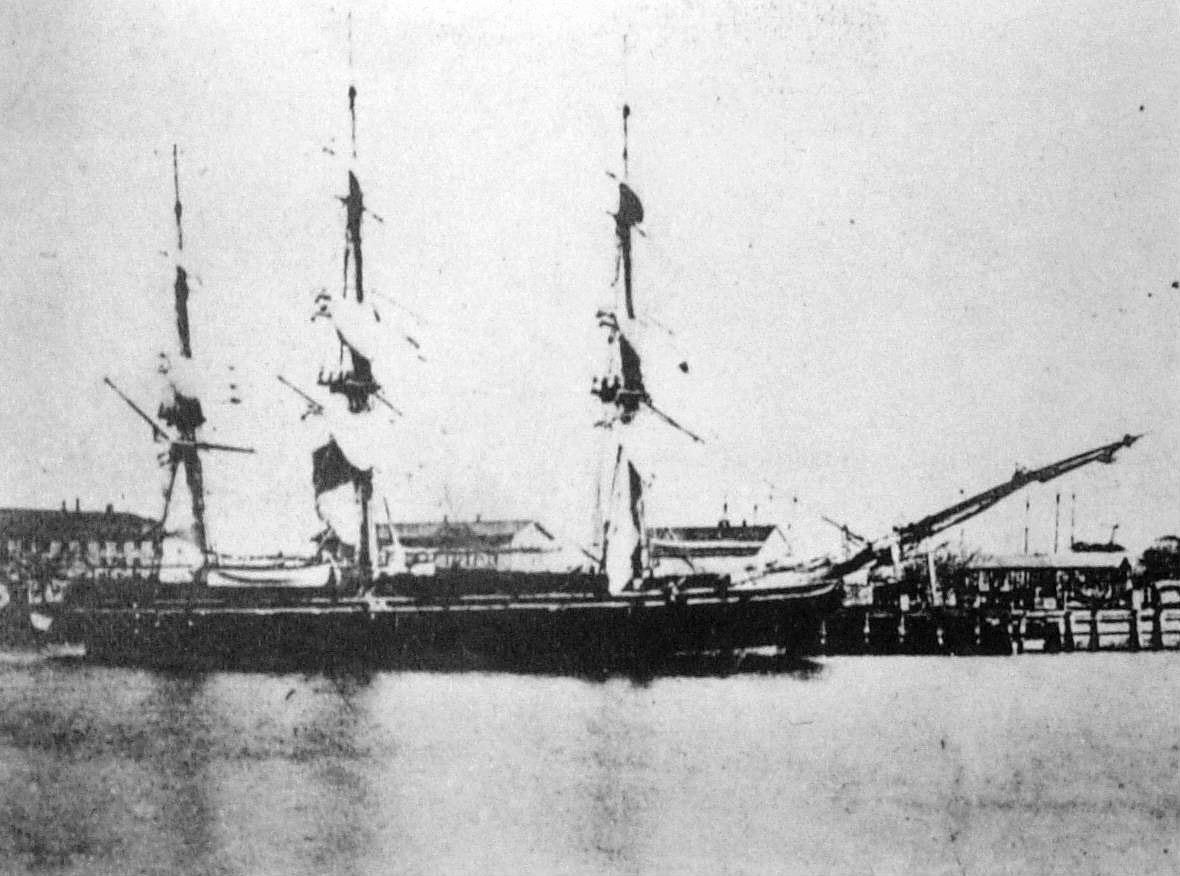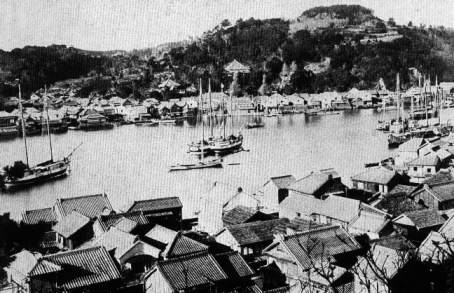|
Kurofune
The Black Ships (in ja, 黒船, translit=kurofune, Edo period term) was the name given to Western vessels arriving in Japan in the 16th and 19th centuries. In 1543 Portuguese people, Portuguese initiated the first contacts, establishing a trade route linking Goa to Nagasaki. The large carracks engaged in this trade had the hull painted black with Pitch (resin), pitch, and the term came to represent all Western vessels. In 1639, after suppressing Shimabara Rebellion, a rebellion blamed on the influence of Christian thought, the ruling Tokugawa shogunate retreated into an isolationist policy, the Sakoku. During this "locked state", contact with Japan by Westerners was restricted to Dejima island at Nagasaki. In 1844, William II of the Netherlands urged Japan to open, but was rejected. On July 8, 1853, the U.S. Navy sent four warships into the bay at Edo and threatened to attack if Japan did not begin trade with the West. Their arrival marked the reopening of the country to pol ... [...More Info...] [...Related Items...] OR: [Wikipedia] [Google] [Baidu] |
Treaty Of Amity And Commerce (United States–Japan)
The , also called the Harris Treaty was a treaty signed between the United States and Tokugawa Shogunate, which opened the ports of Kanagawa and four other Japanese cities to trade and granted extraterritoriality to foreigners, among a number of trading stipulations. It was signed on the deck of the in Edo (now Tokyo) Bay on July 29, 1858. Timeline * July 29, 1858: Treaty and Regulations are signed by the United States and Japan * December 15, 1858: Senate reviews the treaty and consents to ratification * March 19, 1859: Ratified by Japan * July 4, 1859: Entered into force * April 12, 1860: Ratified by the President of the United States * May 22-23, 1860: Ratifications exchanged at Washington and proclaimed by the President * June 25, 1866: Amended through convention * July 25, 1878: Modified by convention * July 17, 1899: Superseded by the treaty of November 22, 1894. The Treaty The treaty followed the 1854 Convention of Kanagawa, which granted coaling rights for Amer ... [...More Info...] [...Related Items...] OR: [Wikipedia] [Google] [Baidu] |
USS Saratoga (1842)
USS ''Saratoga'', a sloop-of-war, was the third ship of the United States Navy to be named for the Battle of Saratoga of the American Revolutionary War. Her keel was laid down in the summer of 1841 by the Portsmouth Navy Yard. She was launched on 26 July 1842 and commissioned on 4 January 1843 with Commander Josiah Tattnall III in command. Service history Ivory Coast Expedition The ship sailed from Portsmouth, New Hampshire, on 16 March 1843, but was dismasted in a gale the next day and forced to return to Portsmouth for repairs. She got underway again on 3 May and proceeded down the coast to New York Harbor to prepare for service in the Ivory Coast Expedition. On the morning of 5 June, she was towed to Sandy Hook, New Jersey, where, at noon, Commodore Matthew Perry came on board and broke his broad pennant as Commander of the Africa Squadron. At mid-afternoon, the ship stood out to sea, proceeded via the Canary Islands and the Cape Verde Islands and reached Monrovia, ... [...More Info...] [...Related Items...] OR: [Wikipedia] [Google] [Baidu] |
Japanese 1854 Print Commodore Perry
Japanese may refer to: * Something from or related to Japan, an island country in East Asia * Japanese language, spoken mainly in Japan * Japanese people, the ethnic group that identifies with Japan through ancestry or culture ** Japanese diaspora, Japanese emigrants and their descendants around the world * Japanese citizens, nationals of Japan under Japanese nationality law ** Foreign-born Japanese, naturalized citizens of Japan * Japanese writing system, consisting of kanji and kana * Japanese cuisine, the food and food culture of Japan See also * List of Japanese people * * Japonica (other) * Japonicum * Japonicus * Japanese studies {{disambiguation Language and nationality disambiguation pages ... [...More Info...] [...Related Items...] OR: [Wikipedia] [Google] [Baidu] |
Uraga Harbor
is a subdivision of the city of Yokosuka, Kanagawa Prefecture, Japan. It is located on the south eastern side of the Miura Peninsula, at the northern end of the Uraga Channel, at the entrance of Tokyo Bay. History With the establishment of the Tokugawa shogunate based in Edo at the start of the 17th century, the small village of Uraga developed rapidly due to its sheltered harbor and strategic location at the entrance of Edo Bay. The area was ''tenryō'' territory under direct control of the shogunate, and the increase in maritime traffic led to the development of merchant and trading firms in the area. In 1720, the shogunate established the post of '' Uraga bugyō'', whose responsibility was to police traffic and to organize coastal defenses, and the entrances to the harbor were fortified with cannon against possible incursions by foreign ships in violation of Japan’s national isolation policy. Still, in 1812, the British whaler stopped at Uraga and took on water, food, an ... [...More Info...] [...Related Items...] OR: [Wikipedia] [Google] [Baidu] |
Arquebuses
An arquebus ( ) is a form of long gun that appeared in Europe and the Ottoman Empire during the 15th century. An infantryman armed with an arquebus is called an arquebusier. Although the term ''arquebus'', derived from the Dutch word ''Haakbus'' ("hook gun"), was applied to many different forms of firearms from the 15th to 17th centuries, it originally referred to "a hand-gun with a hook-like projection or lug on its under surface, useful for steadying it against battlements or other objects when firing". These "hook guns" were in their earliest forms of defensive weapons mounted on German city walls in the early 15th century. The addition of a shoulder stock, priming pan, and matchlock mechanism in the late 15th century turned the arquebus into a handheld firearm and also the first firearm equipped with a trigger. The exact dating of the matchlock's appearance is disputed. It could have appeared in the Ottoman Empire as early as 1465 and in Europe a little before 1475. The he ... [...More Info...] [...Related Items...] OR: [Wikipedia] [Google] [Baidu] |
Nanban Trade
or the , was a period in the history of Japan from the arrival of Europeans in 1543 to the first '' Sakoku'' Seclusion Edicts of isolationism in 1614. Nanban (南蛮 Lit. "Southern barbarian") is a Japanese word which had been used to designate people from Southern China, Ryukyu islands, Indian Ocean and Southeast Asia centuries prior to the arrival of the first Europeans. For instance, according to the Nihongi ryaku (日本紀略), Dazaifu, the administrative center of Kyūshū, reported that the Nanban (southern barbarians) pirates, who were identified as Amami islanders by the Shōyūki (982–1032 for the extant portion), pillaged a wide area of Kyūshū in 997. In response, Dazaifu ordered Kikaijima (貴駕島) to arrest the Nanban. The ''Nanban'' trade as a form of European contact began with Portuguese explorers, missionaries, and merchants in the Sengoku period and established long-distance overseas trade routes with Japan. The resulting cultural exchange inclu ... [...More Info...] [...Related Items...] OR: [Wikipedia] [Google] [Baidu] |
Portuguese Malacca
Portuguese control of Malacca, a city on the Malay Peninsula, refers to the 130 year period (1511–1641) when it was a possession of the Portuguese East Indies. It was conquered from the Malacca Sultanate as part of Portuguese attempts to gain control of trade in the region. Although multiple attempts to conquer it were repulsed, the city was eventually lost to an alliance of Dutch and regional forces, thus entering a period of Dutch rule. History According to the 16th-century Portuguese historian Emanuel Godinho de Erédia, the site of the old city of Malacca was named after the malacca tree (''Phyllanthus emblica''), fruit-bearing trees along the banks of a river called ''Airlele'' (Ayer Leleh). The Airlele river was said to originate from ''Buquet China'' (present-day Bukit Cina). Eredia cited that the city was founded by ''Permicuri'' (i.e. ''Parameswara'') the first King of Malacca in 1411. The capture of Malacca The news of Malacca's wealth attracted the atte ... [...More Info...] [...Related Items...] OR: [Wikipedia] [Google] [Baidu] |
Brooklyn Museum - Commodore Matthew Perry's "Black Ship"
Brooklyn () is a Boroughs of New York City, borough of New York City, coextensive with Kings County, in the U.S. state of New York (state), New York. Kings County is the most populous Administrative divisions of New York (state)#County, county in the State of New York, and the County statistics of the United States#Most densely populated, second-most densely populated county in the United States, behind New York County (Manhattan). Brooklyn is also New York City's most populous borough,2010 Gazetteer for New York State United States Census Bureau. Retrieved September 18, 2016. with 2,736,074 residents in 2020. Named after the Dutch village of Breukelen, Brooklyn is located on the western portion of Long Island and shares a border with the borough of Queens. ... [...More Info...] [...Related Items...] OR: [Wikipedia] [Google] [Baidu] |
Coal
Coal is a combustible black or brownish-black sedimentary rock, formed as rock strata called coal seams. Coal is mostly carbon with variable amounts of other elements, chiefly hydrogen, sulfur, oxygen, and nitrogen. Coal is formed when dead plant matter decays into peat and is converted into coal by the heat and pressure of deep burial over millions of years. Vast deposits of coal originate in former wetlands called coal forests that covered much of the Earth's tropical land areas during the late Carboniferous ( Pennsylvanian) and Permian times. Many significant coal deposits are younger than this and originate from the Mesozoic and Cenozoic eras. Coal is used primarily as a fuel. While coal has been known and used for thousands of years, its usage was limited until the Industrial Revolution. With the invention of the steam engine, coal consumption increased. In 2020, coal supplied about a quarter of the world's primary energy and over a third of its electricity. Some iron ... [...More Info...] [...Related Items...] OR: [Wikipedia] [Google] [Baidu] |
Matthew C
{{disambiguation ...
Matthew may refer to: * Matthew (given name) * Matthew (surname) * ''Matthew'' (ship), the replica of the ship sailed by John Cabot in 1497 * ''Matthew'' (album), a 2000 album by rapper Kool Keith * Matthew (elm cultivar), a cultivar of the Chinese Elm ''Ulmus parvifolia'' Christianity * Matthew the Apostle, one of the apostles of Jesus * Gospel of Matthew, a book of the Bible See also * Matt (given name), the diminutive form of Matthew * Mathew, alternative spelling of Matthew * Matthews (other) * Matthew effect * Tropical Storm Matthew (other) The name Matthew was used for three tropical cyclones in the Atlantic Ocean, replacing Mitch after 1998. * Tropical Storm Matthew (2004) - Brought heavy rain to the Gulf Coast of Louisiana, causing light damage but no deaths. * Tropical Storm Matt ... [...More Info...] [...Related Items...] OR: [Wikipedia] [Google] [Baidu] |
Commodore (USN)
Commodore was an early title and later a Military rank, rank in the United States Navy, United States Coast Guard and the Confederate States Navy, and also has been a rank in the United States Public Health Service Commissioned Corps and the National Oceanic and Atmospheric Administration Commissioned Officer Corps (NOAA Corps) and its ancestor organizations. For over two centuries, the designation has been given varying levels of authority and formality. Today, it is no longer a specific rank within Active duty, active-duty or Military reserve force, reserve forces or in the Public Health Service Commissioned Corps or NOAA Corps, but it remains in use as an ''honorary title'' within the U.S. Navy and U.S. Coast Guard for those senior Captain (United States O-6), captains (pay grade O-6) in command of operational organizations composed of multiple independent subordinate naval units (e.g., multiple independent ships or aviation squadrons). However, "commodore" is a rank that i ... [...More Info...] [...Related Items...] OR: [Wikipedia] [Google] [Baidu] |






.jpg)